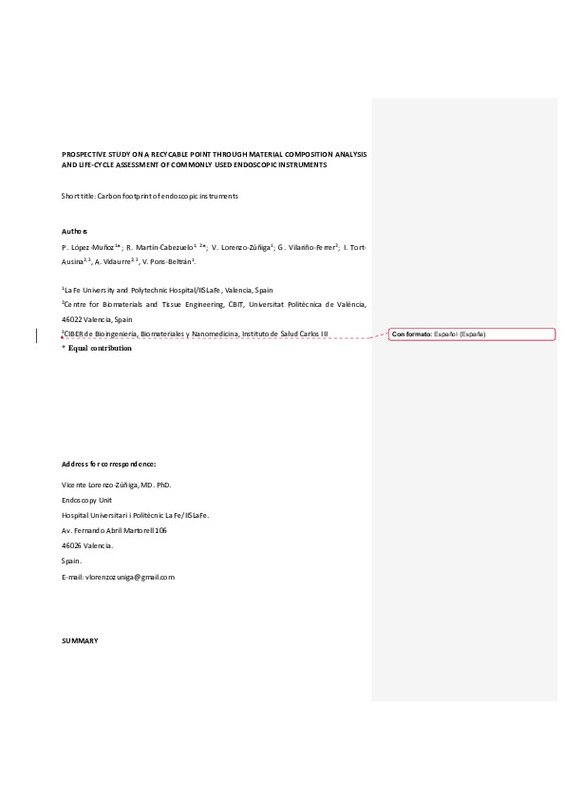JavaScript is disabled for your browser. Some features of this site may not work without it.
Buscar en RiuNet
Listar
Mi cuenta
Estadísticas
Ayuda RiuNet
Admin. UPV
Life cycle assessment of routinely used endoscopic instruments and simple intervention to reduce our environmental impact
Mostrar el registro sencillo del ítem
Ficheros en el ítem
| dc.contributor.author | López-Muñoz, Pedro
|
es_ES |
| dc.contributor.author | Martín-Cabezuelo, Rubén
|
es_ES |
| dc.contributor.author | Lorenzo-Zúñiga, Vicente
|
es_ES |
| dc.contributor.author | Vilariño-Feltrer, Guillermo
|
es_ES |
| dc.contributor.author | Tort-Ausina, Isabel
|
es_ES |
| dc.contributor.author | Vidaurre, Ana
|
es_ES |
| dc.contributor.author | Pons Beltrán, Vicente
|
es_ES |
| dc.date.accessioned | 2024-01-03T19:04:35Z | |
| dc.date.available | 2024-01-03T19:04:35Z | |
| dc.date.issued | 2023-09 | es_ES |
| dc.identifier.issn | 0017-5749 | es_ES |
| dc.identifier.uri | http://hdl.handle.net/10251/201433 | |
| dc.description.abstract | [EN] Objectives GI endoscopy units represent the third largest producers of medical waste. We aimed to determine endoscopic instrument composition and life cycle assessment (LCA) and to assess a sustainability proposal based on a mark on the instruments that identifies parts can be safely recycled or ¿green mark¿. Design Material composition analysis and LCA of forceps, snares and clips from four different manufacturers (A¿D) were performed with four different methods. Carbon footprint from production, transportation and end of life of these instruments was calculated. In 30 consecutive procedures, we marked the contact point with the working channel. 5 cm away from that point was considered as green mark. One-week prospective study was conducted with 184 procedures evaluating 143 instruments (75 forceps, 49 snares and 19 haemoclips) to assess the efficacy of this recyclable mark. Results Composition from different manufacturers varied widely. Most common materials were high global warming potential (GWP) waste (polyethylene, polypropylene and acrylonitrile) and low GWP waste (stainless steel). Significant differences were found for the forceps (0.31¿0.47 kg of CO2 equivalent (CO2 -eq)) and haemoclips (0.41¿0.57 kg CO2 -eq) between the manufacturers. Green mark was established 131.26 cm for gastroscope and 195.32 cm for colonoscope. Oneweek activity produced 67.74 kg CO2 -eq. Applying our sustainability intervention, we could reduce up to 27.44% (18.26 kg CO2 -eq). This allows the recycling of 61.7% of the instrument total weight (4.69 kg). Conclusion Knowledge of carbon footprint is crucial to select the most sustainable alternatives because there are large variations between brands. A mark to identify recyclable parts could reduce our environmental impact significantly. | es_ES |
| dc.language | Inglés | es_ES |
| dc.publisher | BMJ Publishing Group | es_ES |
| dc.relation.ispartof | Gut | es_ES |
| dc.rights | Reserva de todos los derechos | es_ES |
| dc.subject | Green endoscopy | es_ES |
| dc.subject | Material composition | es_ES |
| dc.subject | Endoscopic instruments | es_ES |
| dc.subject | Life-cycle assessment | es_ES |
| dc.subject | Recyclable point | es_ES |
| dc.subject.classification | FISICA APLICADA | es_ES |
| dc.subject.classification | MAQUINAS Y MOTORES TERMICOS | es_ES |
| dc.title | Life cycle assessment of routinely used endoscopic instruments and simple intervention to reduce our environmental impact | es_ES |
| dc.type | Artículo | es_ES |
| dc.identifier.doi | 10.1136/gutjnl-2023-329544 | es_ES |
| dc.relation.projectID | info:eu-repo/grantAgreement/ISCIII/Plan Estatal de Investigación Científica y Técnica y de Innovación 2017-2020 (ISCIII)/PI21%2F00193/ES/DESARROLLO DE ENDOFIS, UN NUEVO PRODUCTO SANITARIO PARA EL TRATAMIENTO ENDOSCOPICO DE LAS FISTULAS POSQUIRURGICAS DEL TRACTO DIGESTIVO/ | es_ES |
| dc.rights.accessRights | Abierto | es_ES |
| dc.contributor.affiliation | Universitat Politècnica de València. Escuela Técnica Superior de Gestión en la Edificación - Escola Tècnica Superior de Gestió en l'Edificació | es_ES |
| dc.contributor.affiliation | Universitat Politècnica de València. Escuela Técnica Superior de Ingenieros Industriales - Escola Tècnica Superior d'Enginyers Industrials | es_ES |
| dc.contributor.affiliation | Universitat Politècnica de València. Departamento de Física Aplicada - Departament de Física Aplicada | es_ES |
| dc.description.bibliographicCitation | López-Muñoz, P.; Martín-Cabezuelo, R.; Lorenzo-Zúñiga, V.; Vilariño-Feltrer, G.; Tort-Ausina, I.; Vidaurre, A.; Pons Beltrán, V. (2023). Life cycle assessment of routinely used endoscopic instruments and simple intervention to reduce our environmental impact. Gut. 72(9):1692-1697. https://doi.org/10.1136/gutjnl-2023-329544 | es_ES |
| dc.description.accrualMethod | S | es_ES |
| dc.relation.publisherversion | https://doi.org/10.1136/gutjnl-2023-329544 | es_ES |
| dc.description.upvformatpinicio | 1692 | es_ES |
| dc.description.upvformatpfin | 1697 | es_ES |
| dc.type.version | info:eu-repo/semantics/publishedVersion | es_ES |
| dc.description.volume | 72 | es_ES |
| dc.description.issue | 9 | es_ES |
| dc.identifier.pmid | 37185655 | es_ES |
| dc.relation.pasarela | S\492447 | es_ES |
| dc.contributor.funder | Instituto de Salud Carlos III | es_ES |
| dc.subject.ods | 03.- Garantizar una vida saludable y promover el bienestar para todos y todas en todas las edades | es_ES |
| dc.subject.ods | 12.- Garantizar las pautas de consumo y de producción sostenibles | es_ES |
| dc.subject.ods | 13.- Tomar medidas urgentes para combatir el cambio climático y sus efectos | es_ES |







![[Cerrado]](/themes/UPV/images/candado.png)

